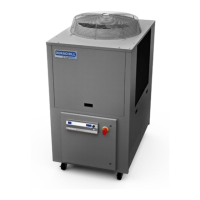Troubleshooting
NOTE: Many problems can be resolved by restoring the factory defaults. If this solves the problem, be
careful when restoring your operational settings in order not to repeat the problem.
To restore the factory default settings:
1. Place the Power Switch / Disconnect in the OFF position.
2. Press and hold the Units/Menu Button (for °F) or the Power Button (for °C) while returning the
Power Switch / Disconnect to the ON position.
WARNING: Service should only be performed by qualified personnel. Extreme caution is required as
hazards are present when servicing this equipment.
WARNING: When electrical power is ON, dangerous voltages exist within chassis components. Use
extreme care when measuring voltages on live circuits.
Troubleshooting Chart
Problem Possible Causes Corrective Action
Unit does not run
(digital displays blank)
No power to unit
Check that the electrical wiring is secure and connected
to an operating electrical source.
Check that Power Switch / Disconnect is in the ON
position.
Check the phase monitor indicator light for correct phase
wiring.
Unit does not run
(three decimal points appear
on Temperature Display,
two decimal points on
Pressure/Flow Rate Display)
Unit in Standby mode Press Power Button on front panel.
No fluid circulation Insufficient fluid in reservoir
Blockage in circulating system
Pump is not operating
Add fluid to reservoir.
Remove blockage.
Replace pump.
Insufficient circulation Fluid viscosity too high
External tubing diameter too
small
Restrictions in fluid lines
Low or high line voltage
Replace with lower viscosity fluid.
Replace with larger diameter tubing.
Check and correct as required.
Check and correct as required.
Unit does not cool or cooling
is insufficient
Dust build up on air filter or
condenser
Blocked air ventilation screens
Facility water too warm
Excessive heat load
Ambient air temperature too
high
Low or high line voltage
Clean air filter and/or condenser as required.
Remove blockages as required.
Check and correct as required.
Check that heat load does not exceed capacity of
Chiller; correct as required.
Decrease ambient air temperature.
Check and correct as required.
Fault code 20 on display Refrigerant pressure too high
Refrigerant pressure too low
Faulty refrigerant pressure
sensor
See Compressor Overload Fault, below.
110-279 36

